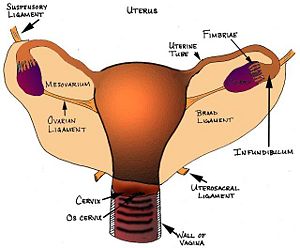Uterus
The uterus is pear shaped, about 8cm long. It connects with the uterine tubes at the top at the sides, and the cervix and vagina inferiorly. The fundus is the part of the uterus that lies above the entrance of the uterine tubes, the cervix at the bottom, and the body in between. The lumen of the body is triangular shaped.
In most women, the uterus is bent forwards over towards the vagina – called anteversion. Often, after pregnancy, the uterus changes position and lies retroverted. This is important, since in a DRE, the retroverted uterus will be very noticeable, and could ring "Oh no its fibrotic!" alarm bells, when in actual fact, its just moved during pregnancy.
The blood supply is mainly from the uterine artery, which comes off the internal iliac. This artery also branches off to supply the cervix and vagina. The ureter runs underneath, so in a hysterectomy there is a risk of clamping the ureter instead of the uterine artery.
The uterus is covered with peritoneum except anteriorly, below the level of the internal orifice between it and the bladder, under the uterovesicularpouch. Between the uterus and rectum is the pouch of douglas (rectouterine pouch).
Clinical Conditions
Congenital Abnormalities
There are a variety of these, but these are usually based on the fact that the two (Mullerian) ducts didn't fuse properly in the embryo. They are pretty rare, but be aware of them.
Chlamydial infection
STD. Produces a severe acute inflammation of the uterus, specifically endometritis.
Fibroids
Smooth muscle tumours, that are benign and common – upto 25% of women. If they present, it will usually be with:
- Abdominal mass
- Urinary problems, due to pressure on the bladder
- Abnormal uterine bleeding
They must be biopsied to check for malignancy, as in some cases they do have malignant potential.
